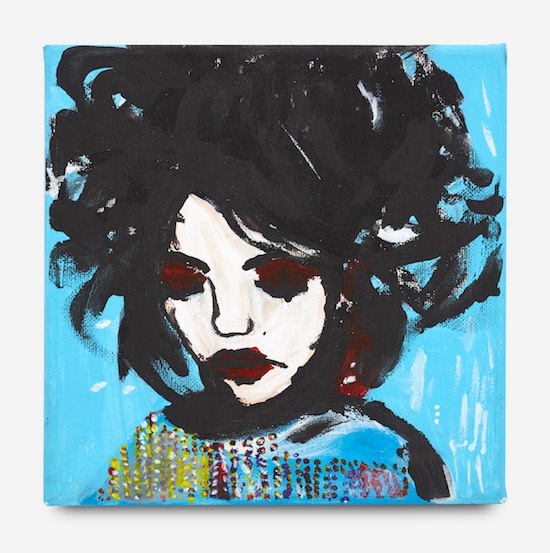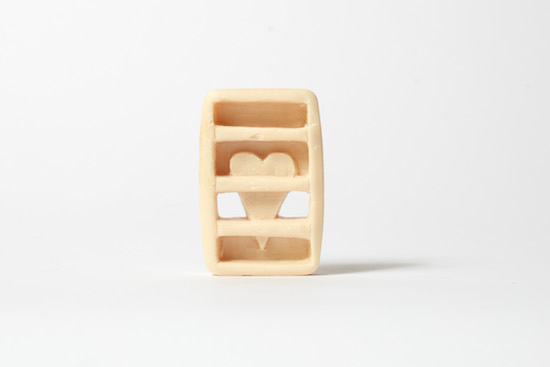Coming Clean, HM Prison Littlehey, soap carving
What does it mean to have a loved one in prison? Being on the other end of the phone . . . sending emails . . . receiving postcards . . . connecting with them daily in thought and action to help them through their sentence?
“Regardless of the crime, we’re all (as a family) doing the time.” Saffron (curator).
This year at the exhibition run in partnership with the Southbank Centre, nine people who have supported family members in prison have shared their experience using artwork submitted to the 2018 Koestler Awards.
The hubbub of colourful, direct art in which people play dominos, in which text messages jostle with colourful paintings of tigers and soaps carved with hearts, expressing love, is in contrast to the overall feeling of the exhibition in 2017, a stark monochrome and bleak selection of work curated by British sculptor Anthony Gormley guided by the title ‘Inside’.
This variety, represented in the display this year and in the variety of curated exhibitions over the years is a strength of the Koestler Trust approach. For the awards over 3,000 people submit pieces of differing forms including ceramics, metalwork, embroidery, animation, drawing, painting, poetry, sculpture, playwriting, music, even hairdressing. This year there were over 50 categories of art. There are a myriad judges and beyond that, artists write feedback. In a mutually appreciative loop, the feedback on this feedback is that it is very helpful and much liked.
As a judge working on the visual art awards for three years I have seen this process from some kind of inside viewpoint and can testify to its beneficial impact on myself as an artist. Seeing so many direct pieces gives me personally confidence to express myself in new ways, less influenced by art school conversations and more in dialogue with how art is perceived outside of the authority of university courses and gallery statements. Ironically, I have been liberated as an artist (in part) by ‘prison art’.

Lucy, HM Young Offenders Institution Cookham Wood, acrylic on canvas.jpg
The first Koestler Awards took place in 1962. The scheme was set up by the writer and campaigner Arthur Koestler, speaking of “an imaginative and exciting way to stimulate as far as possible, and in as many cases as possible, the mind and spirit of the prisoner.” There was no obvious precedent for work by prisoners being judged and rewarded by prominent experts from outside the prison system but the idea was taken up by Home Secretary R. A. Butler. Koestler was reluctant to have the scheme named after him but the steering committee insisted, and the first winners were exhibited in the gallery at Foyle’s Bookshop.
Koestler left £10,000 for the scheme when he died and with no further capital or endowment the Trust have to raise all the funds each year to support their work. The use of his name and the association with his books was his chief gift. Koestler’s Darkness at Noon had a great impact on me as a young writer, giving me a long term interest in the expression of prison diaries such as Gramsci’s Prison Notebooks and Dietrich Bonhoeffer’s Letters and Papers from Prison. I thought how the mental space inside prison walls can lead a person to philosophise and stimulate new ideas through their separation from society. My naive ideas on prison literature as a young reader might have led me to be interested in the Koestler Trust but they have now been challenged by the experience of judging.
And this year I am challenged in my expectations of what an art exhibition actually might be. I am having to consider the question, ‘who is a curator?’ It has been a bold choice to pick curators not for their specialism in art but for their life experience, for their family story. This gives the exhibition of a note of genuine and unfashionable sentimentality. This exhibition has a tender personal note that runs through the work. The overarching word this year is ‘Connections’ and the work is enhanced by quotations from the artists and the curators about this theme.
A seagull flies from a hand reaching through prison bars towards in the blue sky. The artist says, “I feel that the gull is the connection between myself and whoever may also see that bird.” Fellow artist and judge Terence Lambert commented to me on the proliferation of painted words, slogans and messages. Barbara, a mother with a son inside and a selected curator chose the telephone as a symbol of her continued communication with him over this period. Letters with drawings, embroidery with philosophical sayings, pyrographs on wood with words of positivity showed how the curators valued the power of language when used in conjunction with other art forms.
The presence of family is everywhere in this show, a remarkable achievement when the significance of prison is to separate people from their families. A pastel sketch of a family with their backs to the viewer, Back Together symbolises this hope with uplifting turquoise, pink and yellow. Pets and animals are significant. One delightfully observed work presumably from a loved photograph shows a mother lion holding her cub dangling carefully from her mouth. A symbol of family love. Friendship is less prominent but I was particularly moved by Double Six, an image of four men playing dominoes, depicting a moment of peaceful friendship and a light-hearted game inside the prison walls.
Conscious symbolism is brought to life with unusual material. A bouquet of flowers to represent love is created from bread, broom bristles, glue, matchstick and rice. Ceramic birds given flight on wire escape ceramic chains. A collage of a wedding dress is chosen to speak for how a brother was absent from a mother’s wedding.
One charming piece is the cockatoo in a cage in his prison uniform. Its delicate construction makes me remember the care that the Koestler Trust takes with its entries. Unlike so many art competitions these days, the Koestler Trust takes entries in physical forms. Pieces like this are easily broken in transit. They have to be carefully nurtured, sometimes fixed. It’s a joy and a responsibility that is rare in an increasingly digital and sanitised art environment. This art is not ashamed to be vulnerable, exposed, direct and personal and that is why I like it.
I’m Still Here, The Koestler Awards exhibition, is at Exhibition Space, Level 1, Royal Festival Hall, Southbank Centre, London until 4 November


